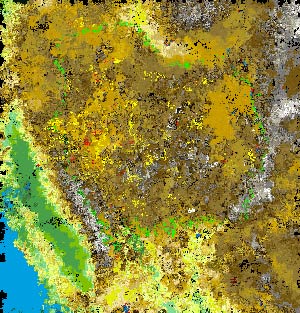BAC
VAI Nevada Neighbors
Program
William L. Fox Essay

—
If you want to see how deeply ingrained our affinity is for such landscapes,
look at the surveys done by the Russian artists Komar and Melamid about
what pictures people all around the world most want to hang on their walls—in
general, a landscape like the one I've described above, preferably with
humans in the foreground. You might also want to look at how you've arranged
your living room—usually with a "picture" window framed with drapes
imitating tree trunks in their folds, a lawn with trees out front, and
if you can afford it, a stream instead of a street, and far mountains.
So Jim came into an environment where there were no trees to speak of,
no water features, and the mountains miles away were standing brown and
in sharp relief. His mind, hardwired to function in a temperate environment,
was trying to interpret the landscape according to its evolutionary template
and at first froze up. Imposing a grid and processing the Great Basin
into art was a way of relating to it. Mary Ann Bonjorni, who had grown
up in the West, when driving out of the ranges and into those hundred-mile-long
valleys we have here, used telephone poles next to the highway to keep
her sense of scale in the landscape. It wasn't a traditional forest, but
it would do. And that led me to consider how we use cultural means to
augment our natural senses in apprehending the natural world, which is
the overarching concern of my work.
I've been wandering around in the company of artists and scientists in
order to watch how we do this, and I find myself telling audiences a story
about how the word "art" is embedded in "cartography" in more than just
a semantic sense. Imagine that you're one of our pre-linguistic primate
ancestors a few hundred thousand years ago and you've just come back from
discovering a waterhole that's out of sight from your band of thirsty
colleagues. You gesticulate and grunt, but no matter how mutely eloquent
you are, fail to communicate to them how to reach the water and game.
In frustration you pick up a stick and, instead of using it to belabor
your point about their ears, press point to ground and draw a simple map
that shows where you are, how to walk out of camp and to the left around
those hills and up the hidden valley to the resource. You've just committed
cartography—which is to say, you've used a visual abstraction to
represent reality, which is perilously close to what we call art.
So what I've been doing is visiting severely isotropic places such as
the Antarctic and the Arctic—arid places on the planet where there
aren't any trees and where the histories of exploration are therefore
readily visible—and looking at the cultural means we use to cope
with them. Most of what I write about is visual culture, such as art and
cartography and scientific images, because eighty percent of what we learn
every day comes in through our eyes. But I also listen to music created
in and about such places, and narratives, both of which have to do with
our experience of time as well as space—and we process the world
in terms of both. I am, so to speak, looking for telephone poles.
—
William L. Fox
2003
—